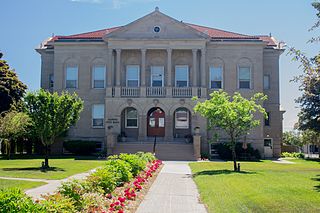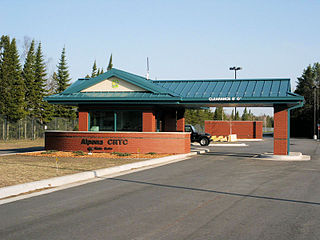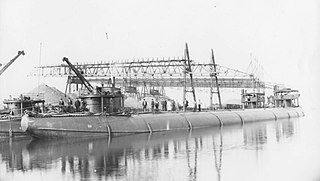
Presque Isle County is a county in the Lower Peninsula of the U.S. state of Michigan. As of the 2020 census, the population was 12,982. The county seat is Rogers City. The county was authorized by state legislative action on April 1, 1840, but the county government was not established until 1871. The government was reorganized in 1875.

Alpena County is a county in the U.S. state of Michigan. As of the 2020 census, the population was 28,907. The county seat is Alpena. It is considered to be part of Northern Michigan.

Alcona County is a county of the U.S. state of Michigan. As of the 2020 census, the population was 10,167. Its county seat is Harrisville. Alphabetically it is the first county in Michigan; as its flag states, it is the "First of 83".

Alpena is a city in the U.S. state of Michigan. It is the county seat of Alpena County, and is the only city within the county. The population was 10,197 at the 2020 census, making it the third most populated city in the Northern Michigan region, after Traverse City and Cadillac. The city is surrounded by Alpena Township, but the two are administered autonomously. It is the core city of the Alpena micropolitan statistical area, which encompasses all of Alpena County and had a total population of 28,907 at the 2020 census.

WPBN-TV is a television station licensed to Traverse City, Michigan, United States, serving as the NBC affiliate for the northern Lower and eastern Upper peninsulas of Michigan. It is owned by Sinclair Broadcast Group, which provides certain services to ABC affiliate WGTU and Sault Ste. Marie–licensed full-time satellite WGTQ under a local marketing agreement (LMA) with Cunningham Broadcasting. However, Sinclair effectively owns WGTU/WGTQ as the majority of Cunningham's stock is owned by the family of deceased group founder Julian Smith. The stations share studios on M-72 just west of Traverse City; WPBN-TV's transmitter is located east of Kalkaska, Michigan. WPBN also operates a low-power digital fill-in translator on UHF channel 22 from a transmitter south of Harrietta in the Manistee National Forest.
The Boyne City Railroad was a railway based at Boyne City, Michigan, U.S., during 1893–1978.

The Alpena Light, also known as the Thunder Bay River Lighthouse or Alpena Breakwater Light, is a lighthouse on Lake Huron near Alpena, Michigan. Standing on the north breakwater of Alpena Harbor, the light marks the entrance to the Thunder Bay River from Thunder Bay. The current lighthouse, built in 1914, replaced earlier wooden structures which had been in use since 1877 and 1888. The current light is a weather-protected structure on a steel frame. It was added to the National Register of Historic Places in 2006, and the state inventory list the same year.
Fletcher Pond is a man-made body of water located in Northeastern Michigan. The pond covers over 9,000 acres (36 km2) of land that was previously cedar forest. A dam was built in 1931 that blocked the flow of the Thunder Bay River to provide reserve water for the Alpena Power Company hydroelectric power plant located in the city of Alpena, Michigan.
The Alpena County George N. Fletcher Public Library is a public library in Alpena, Michigan, United States.

Alpena Combat Readiness Training Center is a Michigan Air National Guard training facility. It is located 7.1 miles (11.4 km) west-northwest of Alpena, Michigan.

SS S.C. Baldwin was a wooden-hulled steam barge built in 1871, that capsized in a storm on August 26, 1908, on Lake Michigan, off Two Rivers, Wisconsin, United States, with the loss of one life. On August 22, 2016 the remnants of S.C. Baldwin were listed in the National Register of Historic Places as reference number 16000565.

SS S.R. Kirby was a composite-hulled bulk carrier that served on the Great Lakes of North America from her construction in 1890 to her sinking in 1916. On May 8, 1916, while heading across Lake Superior with a cargo of iron ore and the steel barge George E. Hartnell in tow, she ran into a storm and sank with the loss of all but two of her 22-man crew off Eagle Harbor, Michigan. For over 102 years the location of S.R. Kirby's wreck remained unknown, until June 2018, when her wreck was discovered by the Great Lakes Shipwreck Historical Society (GLSHS) in 825 feet (251 m) of water, completely broken up.

SS Russia was an iron-hulled American Great Lakes package freighter that sank in a Lake Huron gale on April 30, 1909, near DeTour Village, Michigan, with all 22 of her crew and one passenger surviving.

SS Vernon was a wooden-hulled American passenger and package freighter that sank in a Lake Michigan storm on October 29, 1887, near Two Rivers, Wisconsin, with the loss of between 36 and 50 lives, making her one of the deadliest shipwrecks ever to have occurred in Wisconsin. Only one of the people on board survived.

SS John V. Moran was a wooden-hulled American package freighter in service between 1888 and 1899. She was built in 1888 in West Bay City, Michigan, by F.W. Wheeler & Company. She was built for Ward's Crescent Transportation Company of Detroit, Michigan, and was operated as part of his Detroit & Lake Superior Line. She was built to haul both bulk, and package freight. Throughout the 1893 shipping season, John V. Moran ran between Buffalo, New York, and Duluth, Minnesota. She was sold for the first time in 1895 to the Union Transit Line of Buffalo, and once again in 1898 to the Crosby Transportation Company of Milwaukee, Wisconsin.

Robert C. Pringle, originally named Chequamegon, was a wooden-hulled American tugboat that sank without loss of life on Lake Michigan, near Sheboygan, Wisconsin, on June 19, 1922, after striking an obstruction.

115 was an American whaleback barge in service between 1891 and 1899. She was built between May and August 1891, in Superior, Wisconsin by Alexander McDougall's American Steel Barge Company, for the "McDougall fleet", based in Buffalo, New York. She was one of a class of distinctive, experimental ship designed and built by McDougall. The whalebacks were designed to be more stable in high seas. They had rounded decks, and lacked the normal straight sides seen on traditional lake freighters. 115 entered service on August 25, hauling iron ore from Superior.

104 was an American whaleback barge in service between 1890 and 1898. The fourth whaleback constructed, she was built between October 1889 and February 1890, in Duluth, Minnesota by Alexander McDougall's American Steel Barge Company, for McDougall's fleet of the same name, based in Buffalo, New York. She was a whaleback, a class of distinctive, experimental ship designed and built by McDougall. The whalebacks were designed to be more stable in high seas. They had rounded decks, and lacked the normal straight sides seen on traditional lake freighters. 104 entered service on April 21, hauling iron ore from Two Harbors, Minnesota.















